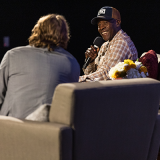New Motion Capture Equipment for Digital Arts students!
October 29, 2013
As part of the ongoing process of updating our equipment, we get a lot of new cameras, lighting, computers, and even software. But undeniably, one of the coolest new acquisitions we’ve purchased recently, is our brand-new set of Xsens Motion Capture suits.
We’ve had a motion capture studio for years now – in fact, we were the first films school to employ this technology for student use – but, as with all things technology related, changes in software and hardware routinely produce significantly better results at a surprising clip – especially where digital artists are concerned. Our digital arts and technology admin teams were thrilled with the Xsens suits we tested, and the time was right, so our digital arts students have some exciting new toys to play with!
In short, the suits are in a kind of testing phase, where we closely monitor their use, as we develop the software and procedures to integrate this highly specialized equipment with our existing data pipeline and infrastructure. But if all goes according to plan, these new suits will eventually replace the current system.
What are the advantages the Xsens offers over our older, wall-mounted units?
Primarily, flexibility. Without going into too much technical detail, the suits allow motion capture artists to work with subjects in a much more free-form environment than the precise “black box” of the motion capture studio. This will enable students to shoot more lifelike scenes, with less focus on the technology, and a closer eye to the movements of actor and camera.
And, the good news, is our students are already up and running with the new suits! In fact, the manufacturers have been working closely with us to make sure all the equipment is running smoothly and calibrated properly. They’ve even taken to their blog, to describe some of the details on the most recent mocap student project, Some Like it Bot:
Read more of what they had to say on the Xsens blog:
Dodge College of Film and Media Arts, part of the Chapman University, is one of the premier film schools in the USA, with all the capabilities of a premier film studio available to students.
Recently, a group of Dodge College students were assigned a project to create a short film using live action, visual effects and interaction between live actors and CG characters. After a few weeks of planning the film which including writing the script, choosing a location, selecting actors and putting a crew together, they were given only one day to learn how to use the Xsens MVN system. Despite the very short time-frame to learn this easy-to-use technology, they were able to learn to work with the MVN suit and shoot the entire film in just three nights, and do it at an off-site location. The amazing result was a short film called ‘Some Like It BOT‘.
Motion Capture
For the first time, they were able to use inertial motion capture in their films. Their previous camera-based motion capture system proved far too cumbersome and far too complex for the students to use for any practical applications. They would often resort to ignoring the motion data they captured and spend numerous hours or days key-framing animations instead. Though, they had this very time consuming work-around, they still required the time-saving benefits and life-like properties of motion capture. That’s why they chose to use the Xsens MVN Suit, which the students were able to learn create animations within a single 3-hour class.
Training
To train the students on the Xsens MVN suit, Xsens paid a visit to Dodge College and were able to teach a classroom of students the setup and operation of the system in the morning. By lunch time, the students independently operate the suit on their own, which lead to a flawless production that weekend.
Set Up
They had experience working with optical motion capture in the studio, but often struggled with every step of the process and required they remain in the studio. The Xsens MVN system, however, could be taken anywhere and turned out to be incredibly simple to operate and quick to setup. A typical setup with the optical system would have taken at least an hour, versus the Xsens suit, which would take just minutes.
Clean up
In past motion capture projects the data needed to be cleaned up so much that it would take hours or days to get usable takes. The data from the Xsens MVN system required minimal clean up and they could even demo and use takes only minutes after data was captured.
As always, the motion capture equipment is managed by the digital arts department, with a special emphasis on thesis level work which can take advantage of the system, both practically artistically. Interested students should contact Professor Bill Kroyer for more information on the learning process.
What do you think of the latest mocap video? Let us know in the comments below!


